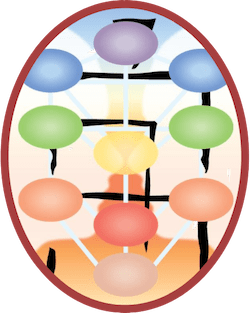Frequently Asked Questions About Kabbalah of the Body
Frequently Asked Questions About Kabbalah of the Body
1. What is the central idea behind the "Kabbalah of the Body" approach?
The core premise is that humans are created in the image of God (tzelem), meaning we share a fundamental likeness with the Divine, extending to our very being. This perspective encourages exploring our own "subtle bodies" – our energetic and spiritual selves – as a path to understanding both ourselves and the Divine. Rather than viewing the body as a limitation, it's seen as a "ladder to the soul", with different parts corresponding to Divine attributes. Therefore, we can explore our own psychological makeup to better understand the nature of the divine.
2. What are the Sefirot, and how are they relevant to this practice?
The Sefirot are ten interconnected facets or emanations of the Divine, described in Kabbalistic tradition as an "interpenetrating web." They are not separate entities, but rather different lenses through which to understand the unified Divine. Because humans are made in God's image, the Sefirot also serve as lenses through which we can understand ourselves. Each Sefira represents a different aspect of God and also a corresponding energy center within the body, allowing us to explore ourselves through this framework.
3. Why is "practice" emphasized in the context of the Kabbalah of the Body?
Spiritual practice is crucial because, according to this perspective, our natural state involves a fragmented view of ourselves, often reducing us to "bits and pieces." Practices like worship and mindfulness help to elevate our consciousness, enabling us to see ourselves from the perspective of the soul, as a totality. This viewpoint allows us to gain clarity about our lives and their purpose, by helping us relate to the body as a vehicle for connection to the soul.
4. How does the concept of "the ladder" relate to the body in Kabbalistic thought?
The "ladder" is a powerful metaphor that appears in various mystical traditions, including Judaism. In the Kabbalah of the Body, the human body is likened to a sacred ladder connecting heaven and earth. It is through the exploration of our own embodied energetic self that we can understand the divine. This ladder is not seen as external or far away but residing within each person, with each “rung” of the ladder grounded in a different part of the body.
5. What is "Ain Sof," and how does it relate to the Sefirot and the concept of creation?
Ain Sof, meaning "without end," represents the first sefirah and is often understood as No-Thing-Ness. It is the boundless, infinite, and unknowable source from which all of creation emanates. It is from this realm of pure potentiality that the first ray of light and ultimately the ten Sefirot emerges, forming the framework of the universe. It is the starting point, and the place from which everything, in its potential, begins.
6. What is "Tikkun Olam," and how is it related to the "shattering of the vessels?"
Tikkun Olam, meaning “repair of the world,” is a core Kabbalistic concept. According to this myth, the ten vessels meant to contain divine light were too fragile, resulting in them breaking and scattering their light. This explains the imperfection of the world as we know it. The concept of tikkun entails the conscious act of "gathering the holy sparks" scattered throughout creation and to elevate them to holiness. Through contemplative action, humans engage in acts of devotion to contribute to the healing of the world and to restore it to its original, perfect state.
7. What are the three constellations described in the Kabbalah of the Body?
These three primary constellations that correspond to different aspects of the Divine, all relating to human experience as well:
- The Mind Constellation (Keter-Hokhmah-Binah): Represents the intellectual and creative aspects of the Divine, also found within human thinking.
- The Heart Constellation (Hesed-Gevurah-Tiferet): Focuses on emotions, love, justice, and the central harmony of existence, again as aspects of both the Divine and our emotional lives.
- The Gut Constellation (Tiferet-Netzah-Hod): Emphasizes our lower centers that help connect us to the world in a practical way.
8. What is the role of the Shekhinah in Kabbalistic thought and how does it relate to the human experience?
The Shekhinah is often described as the immanent, feminine aspect of the Divine that dwells in the world. It is seen as the divine presence that accompanies humanity, especially during times of exile and challenge. Shekhinah is seen as the place where the Divine interacts directly with humanity. The Shekhinah emphasizes the connection between our grounded existence and our spiritual aspirations; both are understood as places where we can encounter the divine. This connection is not only spiritual but also physical and multisensory.
